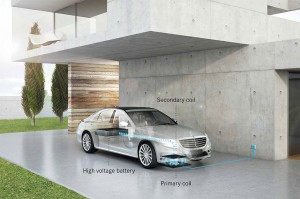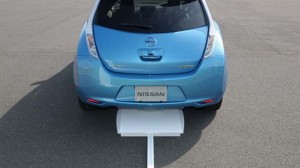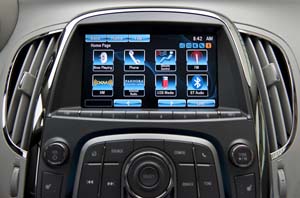In the not-too-distant future, your plug-in may not need to be plugged in.
When the 2018 Mercedes-Benz S550e makes its debut later this year, the plug-in hybrid will not need to be tethered to a charging station to top off its batteries, at least not if an owner has access to use the new Halo systems developed by San Diego-based Qualcomm. All they’ll need to do is position the big Benz sedan over an inductive mat.
Similar technology is already becoming commonplace for cellphones such as the Samsung Galaxy Edge. And a number of automakers, including Honda, Fiat Chrysler and General Motors, are building wireless phone charging mats into their vehicles. But the next step is to amp up the technology so it can wirelessly charge plug-based vehicles.
“This is definitely coming,” Jesse Schneider, the chairman of a wireless task force put together by the Society of Automotive Engineers, said during an industry event in San Diego last month.
(First Drive: 2017 Honda Clarity FCV. Click Here for a review of the new hydrogen car.)
Systems like Qualcomm’s Halo have been in the works for some time. Nissan showed off a prototype when it introduced the Infiniti LE concept battery-electric vehicle at the 2012 New York Auto Show. It also demonstrated a version for the Nissan Leaf – adding the neat trick of having the battery-car autonomously position itself atop the charging mat.
Wireless charging for automobiles is a fair bit more complicated than it is for smartphones and other consumer electronic devices, which is why the technology has been slow to make it into production. And it isn’t an entirely perfect solution. For now, these inductive charging systems can’t transmit quite as much power as a direct, hardwired charging system. That can translate into longer charging times, especially when you’re talking about the new generation of long-range electric vehicles such as the Chevrolet Bolt EV and the Tesla Model S.
That would be less of a headache on the current generation of shorter-range EVs, like the Leaf, of plug-in hybrids equipped with more compact batteries. The 11-kilowatt wireless system developed by Momentum Dynamics for the current Nissan Leaf – which has a range of about 100 miles – can give it a complete recharge in two hours.
(In a class by itself. Click Here to check out the Honda XC90 T8 plug-in SUV.)
Even for longer-range models, experts believe the slower systems shouldn’t be a problem for home charging, where vehicles would be parked inside the garage – and over the mat – overnight. And by making charging up a seamless procedure, it would be more likely, experts contend, that motorists keep their vehicles fully charged. Even with the minor hassle of having to pop open the charger port and plugging in, many owners routinely forget to do that every night.
“Imagine wireless electric-vehicle charging being as easy and widespread as Wi-Fi is today,” said Chris Borroni-Bird, a former advanced tech executive at General Motors, and now the vice president of strategic development at Qualcomm.
Qualcomm is just one of a number of companies developing wireless chargers. The list includes Witricity, Evatran and others. And, industry officials suggested at the San Diego event, virtually every battery-car manufacturer is expected to offer induction systems by the beginning of the decade, at least as an option.
They likely will carry a noticeable premium, starting at $1,500 or more, according to a report by the San Diego Tribune. And EVAtran already offers aftermarket chargers for some vehicles for as little as $1,260.
(Why is Tesla dropping the Model S 60D? Click Here to find out.)
Who will follow Mercedes isn’t clear yet. Nissan has been considering taking inductive charging to production but has not confirmed if it will be offered for the longer-range, next-gen version of the Leaf that it will debut in September. BMW, meanwhile, is using a prototype system on the i8 plug-in sports car that serves as safety vehicle for the Formula E electric racing series. Again, however, it has not said if and when it might launch the technology for its battery i brand or models offered by its mainstream BMW brand.
But, “Automakers know the key to increased EV sales is to improve the charging or fueling experience,” Andrew Daga, CEO of Momentum Dynamics, told trade publication Automotive News. “They want to get inductive charging into the market as fast as possible.”
Once autonomous vehicles start hitting market, inductive systems will become all but required, experts suggest, since they might go off an park themselves, with no one around to plug them in.
How far might wireless induction go? Some researchers are working on systems that could be embedded into pavement, allowing electric vehicles to constantly draw power from the grid, rather than draining their batteries. That concept has been tested in a couple of limited projects, though there are no plans to take it mainstream anytime soon.





I’m thinking the lawyers are already writing their ads, “Are you suffering from the effects of wireless charging? Is your hair falling out, did your belt buckle give you 3rd degree burns? Is your cat nowhere to be found? Call 1 800 SUE THEM.”